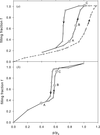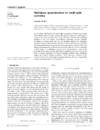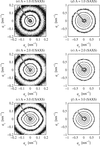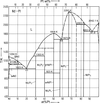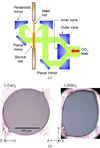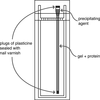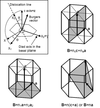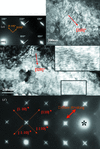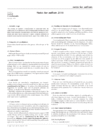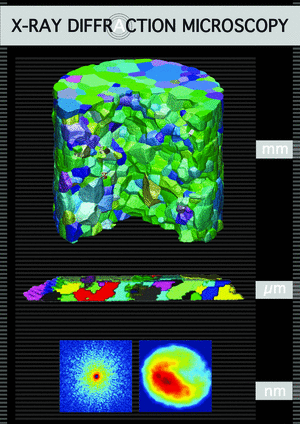issue contents
February 2010 issue

Cover illustration: PDB_REDO optimization of the oldest structure with experimental data in the PDB [155c; Timkovich & Dickerson (1976). J. Biol. Chem. 251, 4033-4046]. Front: final structure - warmer colours show greater atomic displacement. Back: final structure model with atomic trajectories in yellow. Courtesy of Joosten et al. [J. Appl. Cryst. (2009), 42, 376-384].
research papers
The capillary condensation and capillary emptying of water and perfluoropentane in ordered mesoporous SBA-15 silica is studied by in-situ small-angle neutron scattering (SANS). The SANS data can be perfectly described by a simple analytical model for spatially random pore filling (Laue scattering) for the entire range of pore-filling fractions.
The theory of small-angle scattering of a multiphase system, its relation to scattering contrast variation and the ability to extract the scattering pattern of a single phase are considered.
A novel model for the interpretation of small-angle scattering experiments of self-affine structures
A novel theory is presented which allows the analytical description of small-angle scattering experiments on anisotropic shaped clusters of nanoparticles. Experimentally, silica-filled rubber which is deformed is used as an example.
The diffraction-line broadening exhibited by three different Pb3O4 phases was studied at ambient and elevated pressures. The broadening indicates strongly anisotropic microstrain, which was interpreted in terms of (local) stress variations in association with strongly anisotropic elastic properties.
A new method is proposed to improve structure modeling by taking into account the half-wavelength contribution (λ/2) to X-ray data measured on CCD and image-plate diffractometers.
The phase diagram of the Nd–Pt system from 35 to 85 at%Pt has been revised using X-ray diffraction and differential thermal analysis.
Extinction has been found on pole figures measured by neutron diffraction on highly textured high-purity copper. A possible mechanism responsible for the extinction is proposed.
This article defines optimal steric crowding around an apical water molecule. The apical bond length shows sigmoidal dependence on distortion of the coordination polyhedron.
Lithium tantalate (LT) single-crystalline fibers with various growth conditions were obtained using the laser-heated pedestal growth (LHPG) method. To facilitate wave propagation with low loss, glass-clad LT fibers were fabricated by a co-drawing LHPG method for the first time.
A method is described for automated least-squares molecular overlay without a priori atomic correspondence or connectivity information. The method is applied to compare crystallographically distinct molecules in 18 941 single-component molecular crystal structures taken from the Cambridge Structural Database.
This report describes the application of organic solvent gels and aqueous hydrogels for crystallization of soluble and membrane proteins. The hydrogel is based on polyvinyl alcohol and the organic based gels are formed using polyethylene oxide, which is compatible with a variety of solvents. Diffracting crystals were obtained with both gel systems.
This paper describes a technique for collecting X-ray absorption fine structure from perfect crystals, free of large systematic errors.
EVAL15, a novel diffraction data integration method, predicts reflection profiles that are used to determine accurate intensities. It can solve a range of difficult diffraction problems, such as those related to overlap, Kα1/Kα2 peak splitting and satellite reflections.
In nuclear spectroscopy by crystal diffraction, Bayesian inference allows γ-ray photons and rocking angles detected in coincidence to be used to find the location of the diffraction peak without binning the recorded angles.
The phase-retrieving performance of the structure solution methods charge flipping and low-density elimination is investigated. The best strategies are discussed.
A novel procedure for the determination of the molecular weight of proteins in dilute solution from a single small-angle X-ray scattering curve measured on a relative scale is described.
A newly installed small/wide-angle X-ray scattering (SAXS/WAXS) instrument for structural characterization is described. The instrument performance is illustrated via a variety of measurements, including simultaneous SAXS/WAXS and grazing-incidence SAXS from the air–water interface.
The micropipe-induced birefringence of 6H silicon carbide is measured and quantitatively modelled, using the rotating polarizer method.
This work provides a new methodology for the analysis of misorientations in textured materials; its aim is also to shed some light on the development of recrystallization textures in hexagonal materials, which are still largely not understood.
Incommensurate satellite reflections modulating along the 〈110〉* directions have been observed in the electron diffraction patterns of single crystals of the relaxor ferroelectric Pb2ScTaO6 (PST). The satellites represent a weak frustrated antiferroelectric state in PST, termed the incommensurate antiferroelectric state.
Download citation


Download citation


A pseudo single crystal of sucrose (monoclinic, P21) was prepared and the origin of its twin orientation is discussed.
Urea doping leads to the enhancement of second-harmonic generation (SHG) efficiency in tristhioureazinc(II) sulfate (ZTS) single crystals, with a critical dependence on urea concentration. An interesting correlation between crystalline perfection and SHG efficiency has been revealed using high-resolution X-ray diffractometry and Kurtz powder techniques.
Download citation


Download citation


The crystal structures of two pharmaceutical compounds were solved from laboratory and high-resolution powder diffraction data collected at the ESRF Grenoble. The serious problems encountered during an ab initio crystal structure solution from powder data are described and discussed.
Large crystals of two siliceous zeolites have been grown and studied as a function of temperature using bifrefringence microscopy. In one case organic template is retained and the crystals show a reversible, ferroelastic phase transition on heating and cooling, but in another the bifrefringence indicates migration of organic template to the crystal edges upon heating.
short communications
A V-shaped channel-cut X-ray monochromator based on a graded Ge-rich GeSi single crystal with a total asymmetry factor of 21 is presented. It exhibited a peak intensity more than three times higher than that of a V-21 monochromator made of a pure Ge crystal.
computer programs
A close-contact penalty factor has been added to the GEST structure solution from powder diffraction data software to differentiate chemically unreasonable structure models from potentially correct models. It has proved an effective method to eliminate chemically unreasonable trial models.
A cross-platform program, ISAACS, has been developed to analyze the structural properties of three-dimensional structure models obtained using computer simulations (molecular dynamics, ab-initio molecular dynamics, reverse Monte Carlo, Monte Carlo etc.). A wide range of calculations can be performed, including radial distribution functions, simulation of neutron and X-ray diffraction, ring statistics, and spherical harmonics.
An expert system for macromolecular crystallography data reduction using existing software, xia2, is presented with examples of its application to a range of data sets.
A plug-in (EXTRAX) has been developed for ImageJ – a public domain Java-based program widely used for image processing and analysis in microscopy. This plug-in allows the extraction and measurement of intensities from electron diffraction spot patterns with a semi-automatic peak location based on a two-dimensional lattice given by the user.
A web-accessible resource has been created to study the interactions of various metal ions present in macromolecular structures.
An online web server coupled with a knowledgebase has been created to study the interactions of various ligand molecules with three-dimensional macromolecular structures.
This paper describes a computing server, SSMBS, which can locate and display the occurrences of user-defined biologically important sequence motifs (a maximum of five) present in a specific order in protein and nucleotide sequences.
laboratory notes
Safety considerations involving `icing-up' with solid air of the sample space of top-loading cryostat equipment are discussed, where uncontrolled de-icing may cause a flash-to-gas, leading to trapped volumes being placed under high pressure. Methods of prevention and resolution of freeze-ups are elaborated, and a case is made for using a helium leak detector as part of sample changing.
international union of crystallography
Free 



 journal menu
journal menu








